There are a lot of different, and very useful items in a DJ’s arsenal.
From looping to scratching, to mixing, to understanding EQ settings, a trained and experienced DJ can perform a variety of different actions to make their performance a truly stellar one.
However, while all of these different aspects and features are certainly important (and believe me, they are very important), none are quite as important as the most fundamental of features, using DJ sound effects.
Considered one of the earliest and most foundational aspects that all beginner DJs should have a handle on, sound effects are an essential tool that all DJs have access to.
Not only does this give them numerous ways to make an otherwise well-treaded song their own, but it can also be an effective way to handle a potentially sticky transition.
The challenge, however, ultimately comes in the fact that, because sound effects are so easy to use, and such a foundational staple in the DJing space, they can oftentimes be overused or made out to be something of a crutch that a DJ can rely too much on, even when they don’t necessarily need it.
In this guide, we’ll be going into detail about what DJ sound effects are as well as the top 5 effects that all beginners should start with first, before doing anything else.
We’ll also go over some of the most optimal times that you can add these effects into your performance.
Using DJ Sound Effects (in short)
DJ sound effects, also known simply as Effects (or FX), are a small variety of different preset options that can be used to alter the way a track sounds. These effects can range from fairly subtle alterations to the sound, to completely warping it. While not an exact 1-1 comparison, effects aren’t too dissimilar to EQ leveling.

RELATED ARTICLE: What Are DJ Loops (How to Use Them Properly)
DJ Sound Effects: Hardware vs. Software
Most DJ controllers generally have a built-in FX feature included in the hardware.
The amount of control offered, as well as the number of options included, can vary from controller to controller. Generally, the higher the controller or mixer’s quality, the more FX options it will have.
In most instances, your DJ software should also have a variety of sound effects that are available when fully installed. This is usually better, as they’re generally a wider variety of FX options to choose from online than what is currently existing on your controller.
Sound Effects On Hardware
When it comes to the different effects on a DJ controller’s hardware, you can generally find them located near the top of the unit; and, while this isn’t true every single time or for every single controller out there, it does seem to be the most likely area for them to be.
This is especially true when it comes to smaller DJ controllers.
As their size typically doesn’t warrant a lot of space for different buttons and knobs, it only makes sense that they are placed at the top of the controller to maximize what space is available.
Having your controller effect options easily reachable and well-positioned is important, even if you don’t plan to use them for every single performance or as much as someone else.
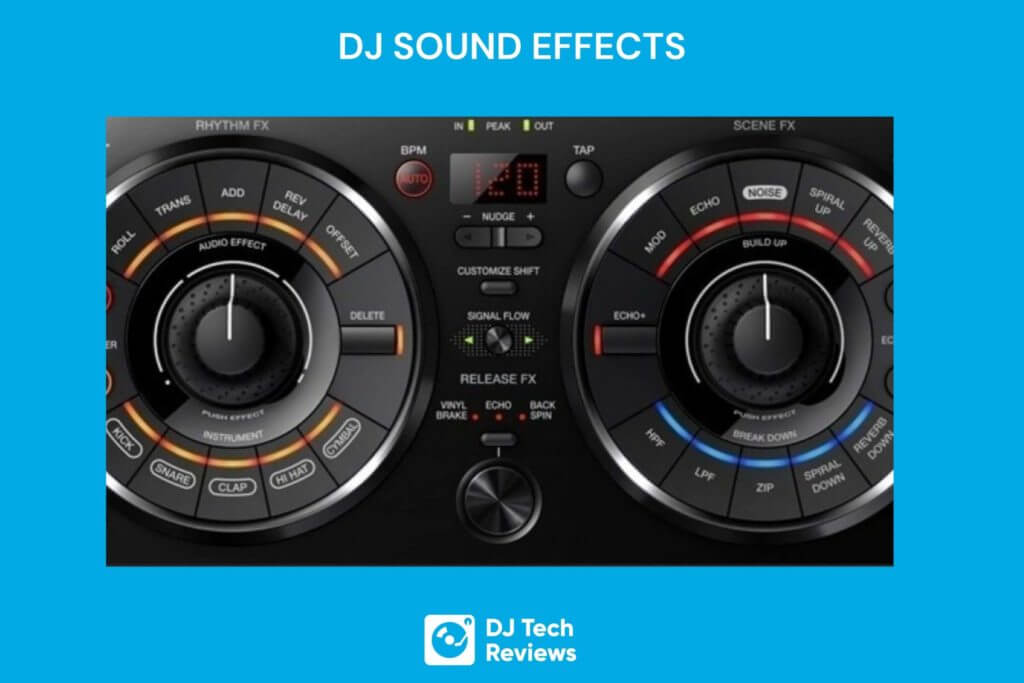
Sound Effects On Software
When it comes to your DJ software, one thing you’ll want to consider and be aware of is the number of available effects that are included.
Generally, the free options will only have a small number of effects available, with the paid (or “pro”) versions having everything else.
As stated earlier, one of the great things about software-based effect options is that they can be added to with an update or through the use of other recording or sound features.
This makes it a great option for those looking to experiment and play with as many different sound effect variations as possible.
The Dry/Wet Mix
While effects do use a button to turn off or on, the amount of each effect that is used to impact the music is determined largely by way of several different knobs.
These knobs are known as the “dry/wet mix”.
A sound effect is considered to be “dry” when it is placed at the lowest setting and will only play a track’s source music, completely without any FX alterations.
Conversely, as you turn the knob, you are increasingly making the sound “wetter” by way of adding more and more balance between the effect and the source music.
As an example, if you have a knob that is set halfway between music and the FX settings, you will be playing 50% of your sound from the source music while the other 50% will be from altered effect music.
Similarly, if you were to have the knob set 2/3rds of the way in favor of music over FX settings, you will be playing 70% of your sound from source music while only 30% will be from altered effect music.
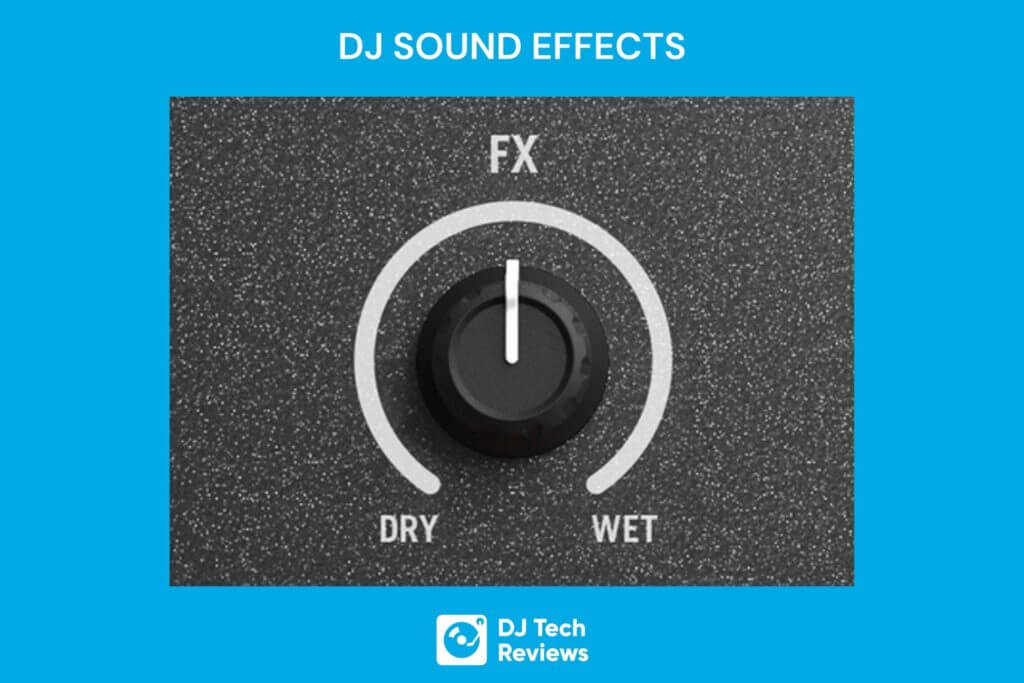
Top 5 DJ Sound Effects
Since we’ve had a chance to go over what sound effects are, as well as where they are positioned (both on the controller as well as with your respective DJ software), let’s now jump into the top 5 most common sound effects available as well as how to best use them with your DJ sets.
FX #1. Filters
Arguably one of the most popular effects in a DJ’s arsenal, even getting its dedicated knob on most controllers, the Filter FX feature allows you to impact and control the frequencies being played.
When turning the knob from its neutral middle point to the left, it will activate the low pass filter.
Conversely, when moving the knob over to the right, it will activate the high pass filter. As the low pass filter is activated, it will remove all higher-end sound frequencies.
The further you turn the knob to the left, the lower the frequency cuts will be.
When it comes to the high pass filter, the opposite is true. As you turn the knob further to the right, you will begin cutting out all low-end frequencies.
And, just like with the low pass filter, the further you turn the knob, the higher your frequency cuts will be.
Filter Effects For DJs
Filter effects are great for DJs and music producers alike, as it adds color and depth to a track. DJs greatly enjoy this feature, as it is a great tool for building up drama or creating a break in a sound where there wouldn’t be one otherwise.
Electronic music, in particular, is well known for using one or both aspects of filtering, often resulting in some incredible performances.
One example of filtering would be where right before a major drop happens, the DJ activates the effect, either raising the sound incredibly high or bringing it down even lower than it already is before bringing it back to the neutral state for the drop.
Transitioning With Filter Effects
You can also use filter effects to assist with track transitions and transfers. When mixing between the two tracks, you can use the filtering effect to fade out the original track while allowing the second track to better ring through. So long as you can keep things on time musically, this can effect can be very effective.
By gradually activating the low pass filter throughout the phrase’s course, you can effectively fade out one track while leaving a space open for the second.
You don’t want to use the filter aggressively in this case, as it can potentially lead to a very jarring and noticeable cut away.
Instead, you’ll want to give yourself more than enough time to slowly and methodically increase the filter level, creating a smoother sound transition.
By practicing and mastering the filter button feature, you can dramatically improve your mixing abilities while also giving yourself the full freedom to better inject a natural-sounding transition point to any track you’re playing with.
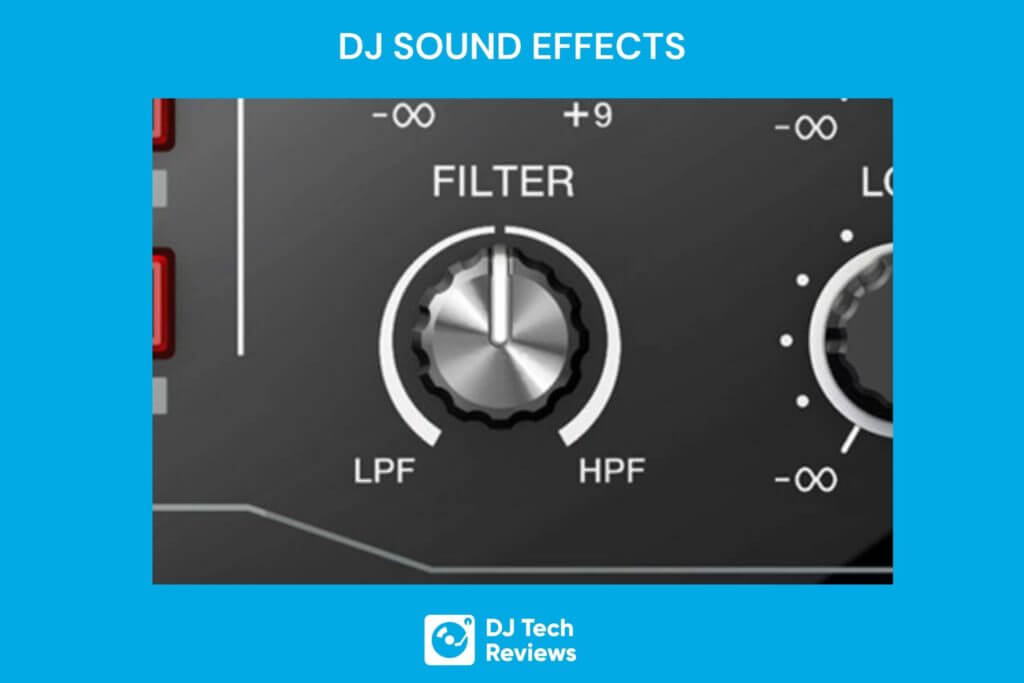
FX#2. Phasers
While not quite on the same level as the filter effect, phasers are a fairly popular and enjoyable DJ effect that has been used consistently since its inception.
The phaser effect works by altering a music’s sound in a way that makes it seem like it is coming from a rotating speaker.
This can, understandably, add a ton of dynamic energy to a track and how it is heard.
When using the phaser effect, you open yourself to several different parameters. These generally include altering the depth and the length of the phase sound. As the sound phase becomes deeper, so too does it become more pronounced on either end of the sound spectrum.
The length of the sound phase is used to dictate how long a phase effect will go before returning. Imagine altering the speaker’s rotating speed.
The Best Place For Phaser Effects
Phaser effects are best used with the more melodic elements with a specific track. This can create a more sweeping panoramic feel to the music.
Phaser effects can also work well with performance pads due to their ebb and flowing nature, creating longer breakdowns within the tracks.
The Worst Place For Phaser Effects
While phaser effects work well with melodic elements, they aren’t nearly as good when it comes to heavier bass sections of music.
This is because phase effects are, more often than not, likely to distort the audio sound to a point where it can easily be pushed over into the red.
As you set up your DJ software, make a point of playing with some of the different phaser parameters to better determine how it impacts the various aspects of a track’s sound.
That way, you can better familiarize yourself with where the sounds work well and where they don’t.
When properly used, at the proper time, a phaser effect can be an awesome tool that adds a deeper and more dynamic sound to your performance sets.
Conversely, if used incorrectly, or at the wrong time, phaser effects can potentially create a horrible audio listening experience for everyone involved.
FX#3. Flanger
Somewhat similar to the phaser effect, the flanger is a phase-based effect that creates a “swooping” effect to a track’s music.
However, whereas the phaser can have this effect sound somewhat light and subtle, the flanger effect is much more aggressive and abrasive.
Similar to the phaser, the flanger effect allows you to manipulate and alter the length and intensity of the flanger in a track. This is often used when building a track up right before a drop, and it can be used to effectively lift or bring down the sound in anticipation of the drop’s release.
Risks Of Using The Flanger Effect
Be aware that, more so than the phaser effect, the flanger effect can be very tricky to pull off and use correctly. This is largely due to its much more aggressive use in comparison.
Because of this, the flanger effect can easily overwhelm a track, potentially putting out some very harsh tones.
You’ll need to constantly monitor your sound levels when using this effect if you are planning to use DJ speakers.
Again, like with these other effects, you’re going to need to play around with it and see how it works for you before deciding to add it to your sets. You’ll also want to make a point of using the flanger effect in time with the structure of the track.
As an example, activating the flanger during the last 16 beats before a drop can create a lot of drama if timed correctly.
FX#4. Reverb
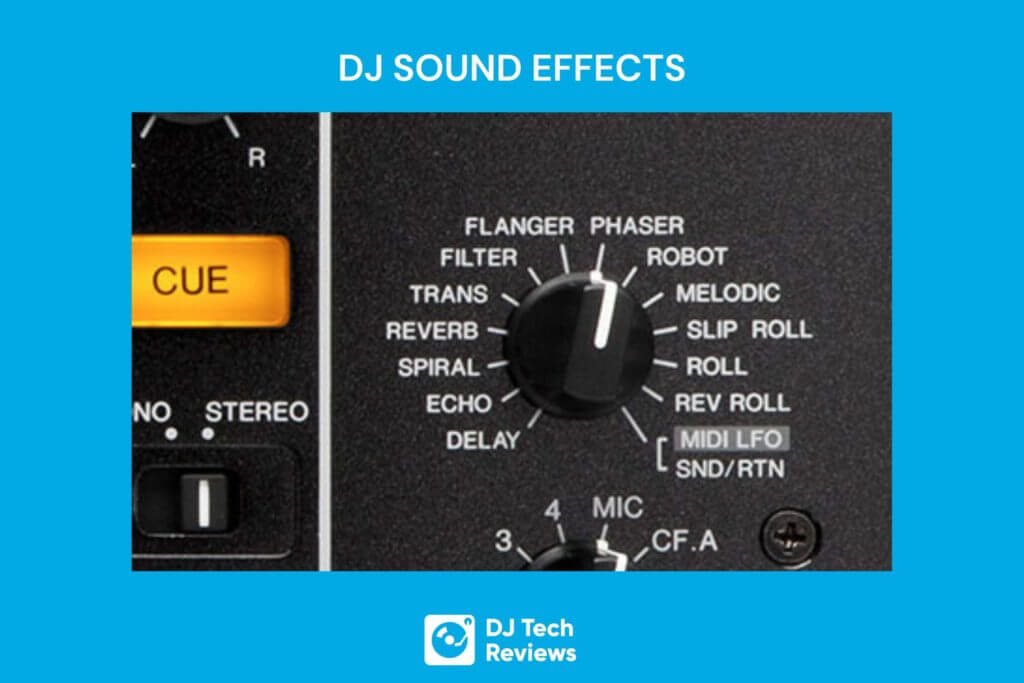
A fairly clever effect, reverb works by creating the auditory illusion of you performing in a larger space or venue.
Think of it as if you were playing your track in a large stadium or cathedral as opposed to your home studio or a relatively small room. It offers that same “echo” feel as if you were in space several times larger.
You can apply more reverb to the settings by turning the knob over. This can create an even greater effect, essentially “building” on the size of whatever space it is replicating.
Reverb is great for breaking down a track’s sound to better give it more emotion or to add a more haunting feel to the music.
Reverb is also an awesome method of establishing a deeper edge to one’s vocals, making them stand out more as a result.
Risks Of Using The Reverb Effect
Reverb, while very useful, does have some challenges based on the situation.
The clearest issue is that it can be difficult to balance out to find the sweet spot with a specific track. The more reverb is added, the higher chance you have of creating a distant and hollow-sounding stage.
This can, rather than improving the quality of the sound, create a slightly haunting sensation that detracts from the overall sound quality.
Using Reverb Effects In Transitions
In addition to its regular use, reverb effects can also be used in transitions.
By making the existing track seem further away than the newer track, you can create a sense as though one is moving further away and making space for the second, all while maintaining a seamless listening experience.
This goes doubly for the second track as well. Not only can you make the existing track sound further away with the reverb effect, but you can use reverb for the newer track to make it seem as if it is coming closer. This can make the sound transition even more pleasant to listeners as a result.
FX#5. Echo
Lastly, we come to the echo effect.
This effect, more so than the others on this list, is fairly straightforward, coming across as pretty much exactly as its name implies. The effect will cause the sound to repeat a particular section of a song from when it was activated, progressively lowering and reducing in volume over time.
The amount of time that the echo exists is largely determined by how far along the “wet” side of the knob is pushed. The more it is pushed, the longer the echo will be heard.
Using Echo Effects In Transitions
The echo effect is very effective when setting up a transition between two songs. By applying the echo effect to the first track at the final beats of the sound phrase, you can let the sound carry over while the second track begins to play.
Additional Benefits To Using The Echo Effects
Outside of being an effective transition tool, the echo effect also works well with slower basslines.
Because they normally tend to echo a bit anyway, adding the echo effect can work to add more depth to an otherwise flat-sounding track.
Echo effects are also an ideal option for vocalists and those that wish to add a vocal element to their performance sets. As it pertains to vocals, you’ll want to make sure that the section is as clean as possible before trying to add an echo to it.
This is because an echo naturally pulls in additional nearby sounds in addition to the top track. If done poorly, this can create a mix that comes across as very “busy”.
Again, it all comes down to playing around with the effects to better familiarize yourself with how the effect works before using it in a professional or performance set.
Consider starting with shorter echo effects and progressing further from there.
If you enjoy the shorter options, you may not even need to move the knob very far toward the wetter side of things.
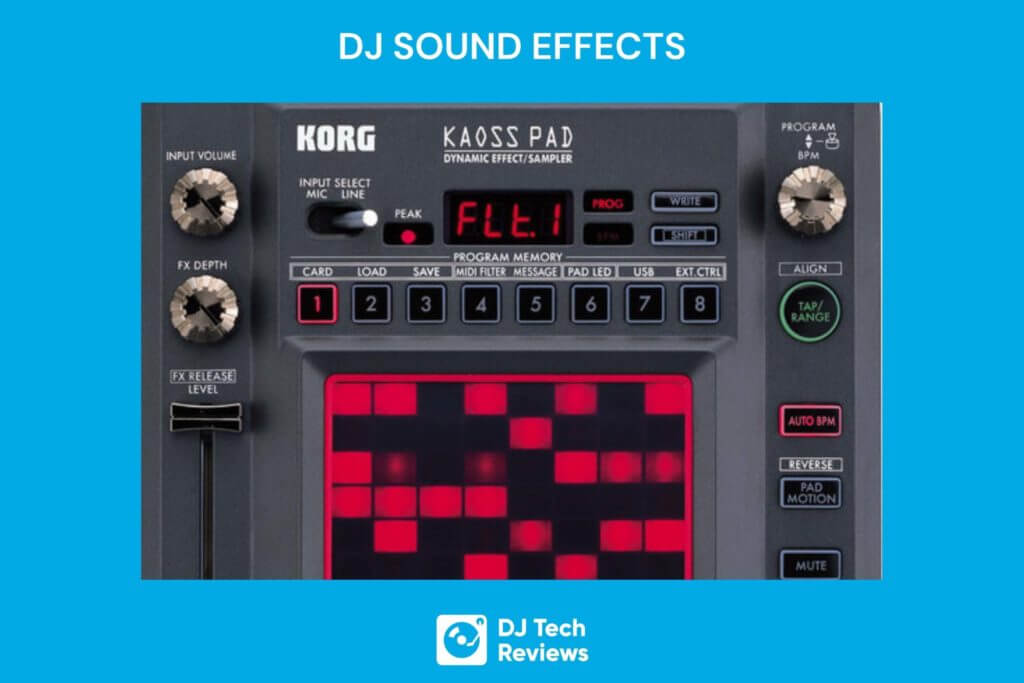
RELATED ARTICLE: Numark Mixtrack Platinum FX: Any Good?
Using DJ Sound Effects Properly: Takeaway
The biggest takeaway from this should be that, while using DJ sound effects properly is a foundational aspect of a DJ’s musical arsenal, that doesn’t make them any less effective in creating an enjoyable listening experience if done correctly and properly practiced.
By correctly giving your sound effects their just due, you can create some truly dynamic sets with your performances, both from a creative side as well as from the strictly technical aspect of things.
Play around with the different sounds.
Practice your timings and you can leverage these 5 DJ effects to make your DJ sets truly ones to remember (in all the best ways possible).




